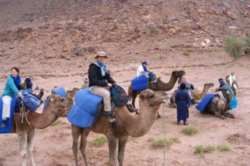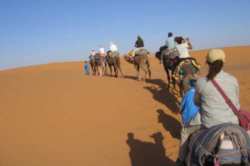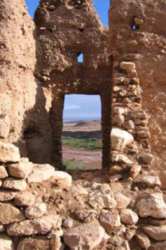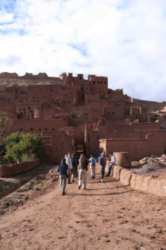When my friend suggested a caravan holiday, this wasn’t exactly what I had in mind. Instead of huddling over fish and chips on a windy seaside cliff top, I found myself on a magnificent camel trek through the Moroccan desert; for this was a ‘caravan’ in the traditional sense of the word.

My Best Friend The Camel
Our journey began with a drive to Ouarzazate, an original staging point for trans-Saharan caravans, which gave us a chance to get to know our fellow desert trekkers. The group contained a dozen passengers from all walks of life, ranging from a girl in her 20s who was travelling alone, to a couple, a group of three friends and a retired divorcÈ, making the most of his new-found freedom.
With minimal riding experience and having never even seen a camel up close, I wasn’t quite sure how I’d adapt to the nomadic lifestyle. Luckily, we were eased in gently and after loading up the camels with our luggage, food and equipment, we only had a short distance to travel into the desert to reach our camp for the first night. For the next four nights we would be sleeping in communal Bedouin-style tents made up of woven fabrics and animal hides stretched over wooden props.

While our hosts prepared a delicious meal of soup, tagine, couscous and mint tea, I took the opportunity to lie back on the desert sand a little way from the camp and marvel at the swathe of white stars splashed across the night sky. This was the same sky I could see back in Britain, but the complete desert darkness made it seem like the entire solar system had been squashed to fit the sky above Morocco, just for my enjoyment.
The following morning, our guides showed us how to fashion shesh – the headscarves typically worn in this region of the Sahara desert by nomadic people such as the Bedouin and the Touareg. These would protect us from the sun and the sand as we began our desert caravan in earnest.
Each member of the group had our own camel and we rode in single-file – less like an armada of ships in the desert perhaps, than a colourful, jovial, slightly wobbly snake moving through the rocky, sandy desert. Led by camelteers on foot and accompanied by porters, guides and extra camels to bear our loads, it struck me just how many thousands of years the traditions of the desert caravan stretched back.

Our purposes in undertaking the trek – for pure pleasure, curiosity and escapism – may have differed from the vital journeys of ancient traders, but our actual experience had evolved only slowly. We still travelled, slept and prepared food in the same way, but our journey was punctuated with a few more modern conveniences – I, for one, was grateful of the padding that softened the camel saddles, a camera to capture our journey and the opportunity to open up a cereal bar or a bottle of water whenever I felt the need.
Certainly the landscapes of the more remote areas we passed showed little evidence of 21st century life. Our route followed the path of a river running south through the Draa Valley and the scenery was more diverse than I had imagined. Crumbling Kasbahs and desert oases sat against a backdrop of sand dunes up to 50 feet high, while extraordinary rock formations grew from the ground in small clumps like natural check points, set there to guide traders along their routes.
We weren’t completely away from civilisation however and over the next three days we passed through a number of villages where we had the chance to see people going about their daily lives – drawing water from wells, collecting grass dates and tending crops – as well as pausing to play football with local children.

It sounds clichÈd, but the way of life out here in the desert led us all to think about our lives back home – how we put so much value on possessions, career and the value of ‘stress’ as a measure of success. It amused us to think that if we were to be stranded here, our collective ‘transferable’ skills and key achievements in life would be of almost no use at all – with the notable exception of Liz, an intensive care nurse.
The final destination for our Moroccan camel caravan was the village of Ouled Driss. We were all sad to leave behind the camels and camelteers who had made our desert adventure so memorable - and returning to the world of motorised vehicles and general noise took some adjusting to.
The return journey to Marrakech took place by four-wheel drive, with a brief detour to Ait Benhaddou, a well preserved Kasbah that has been used as backdrop to many Hollywood films including Gladiator and The Living Daylights.

The bustling streets of Marrakech were a world away from the peaceful desert sand dunes, but the maze of narrow alleys and shops selling all manner of curios and souvenirs were irresistible nonetheless. We ate dinner on a balcony overlooking Plaza Djemaa el Fna, the city’s main square, from where we had an excellent view of the activity going on below – snake charmers and acrobats performing for money, market stall holders selling vibrant-coloured spices and tourists taking sight-seeing tours by horse and carriage.
Marrakech propelled us city slickers back into the modern world, preparing us for our return to urban comforts. And while this desert adventurer had thoroughly enjoyed a taste of the nomadic lifestyle, he also appreciated the lure of a hot shower and a cold beer.
By Martin Henderson
Martin Henderson travelled to Morocco with The Adventure Company. The eight-day Desert Adventure trip starts from £739 per person, plus £80 local payment on arrival. Price includes return flights from London, accommodation, transportation, the services of a local guide and camel trek staff, plus most meals (seven breakfasts, three lunches, four dinners).
Land-only prices are available from £399 plus £80 local payment per person. Regional flight departures can be organised on request.
Tagged in Travel

